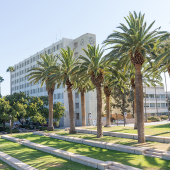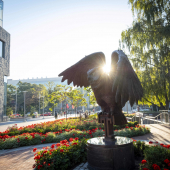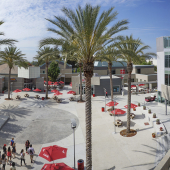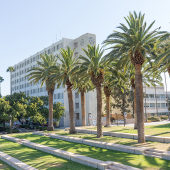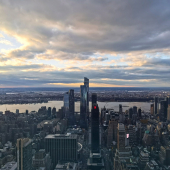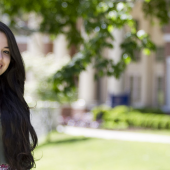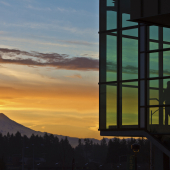Buenos Aires was so named for the warm and pleasant winds which brought sailors and travellers from around the world to its shores. Just as those winds are yet to abate, Buenos Aires continues to welcome all comers, from all corners of the globe.
To this day, opportunities for travellers and students abound in the city, whose rich culture, vibrant diversity and strong, unique identity make it the perfect place to soak in, appreciate and come to understand the parts of life that may not perhaps be accessible elsewhere.
Vibrant and Welcoming
The city of Buenos Aires was first established in 1536 under the expedition of Pedro de Mendoza, whose settlement is now located in the San Telmo district, south of the city centre. Since then, the city has continued to grow and a recent census indicated there were just under 3,000,000 people living in the city, with around 13,000,000 living in Greater Buenos Aires.
Colloquially known as porteños, for the port that supports the city, residents of Buenos Aires now include European descendants, a large Jewish community, and a great deal of Chinese immigrants. Catholicism is the most prominent religion, but it is also home to Buddhists, Muslims and many others. It is, in short, one of the most diverse cities on the planet.
This has meant that while Argentinian Spanish remains the foremost language, one which in itself is influenced by Italian, a plethora of dialects can be heard when strolling through the city, including English, Portuguese, Italian and German, in addition to indigenous languages such as Mapuche, Guarani, Aymara, Toba and Quechua.
This formulation of indigenous Latin American and European elements has led to an intriguing and unique surrounding often described as the ‘Paris of Latin America’. The cobbled streets and gothic architecture inherited from Europe may have also had a hand in this definition.
The heart of the city, though, is undoubtedly Latin American, with tango the pulse. The sensual Argentinean/Uruguayan dance is performed throughout the city, in pubs and bars, in dance schools in halls, even on the streets.
Perhaps in part due to its multiculturalism over the past 150 years, Buenos Aires has historically been Argentina's main venue of liberal ideas. The acceptance of all sorts of people has led to an intriguing and constantly developing identity, which is both Argentinian and worldly at once.
No wonder then that more than 60,000 young people from all over the world chose it as a study destination during 2017. In addition to the vibrant cultural life, the quality of the educational institutions makes it a top-level academic destination. Last year, Buenos Aires led the ‘QS Best Student Cities’ among cities in Latin America.
An academic trip filled with culture, understanding and acceptance can be a turning point that prepares students to live in today's interconnected world. And for that, what better way to do it than in Buenos Aires, the safest city in Latin America, according to ‘Safe Cities Index 2017’ and the best for living, according to ‘Most Liveable Cities Index 2017’, each carried out by The Economist Intelligence Unit.
Some of the best universities in Buenos Aires include the University of Buenos Aires, the University of Palermo, Torcuato di Tella University and Austral University, each of whom offer a wide range of courses and degree options. In fact, there are more than 40 universities in the city and metropolitan area, each of which is an excellent choice for a venturing international student.
Further, a wide range of colleges offering unique and excellent educations are present in the city. A good place to start when considering where and what to study would be Study Buenos Aires.
Intellectually Spectacular
We have mentioned the city’s culture a few times, but what does that actually entail? Art? Literature? Language? Music? Cinema? Fashion? Architecture? Parks? Theatre? Sport? Well Buenos Aires has been blessed with each of them.
In the second half of the 19th century, in addition to increased numbers of international residents (and therefore wealth raised by customs), the development of the railroads and plentiful fertile soil led to Buenos Aires becoming a very wealthy area.
Between 1880 and 1930, this wealth led to the city’s main avenues being built and the development of Buenos Aires into the country’s capital of radio, television, cinema and theatre. During the dawn of the 20th century, some of South America’s tallest buildings (at the time) were built alongside its first underground system. This rapid evolution made Buenos Aires one of the cultural capitals, not just of South America, but of the world.
Buenos Aires has a thriving arts culture, with a huge inventory of museums, ranging from the obscure to the world renowned. Palermo and Recoleta are the city's traditional artistic hubs, although in recent years there has been a tendency for exhibition venues to appear in other districts, such as Puerto Madero or La Boca. Famous venues include MALBA, the National Museum of Fine Arts, Fundación Proa, Faena Arts Center, and the Usina del Arte.
Buenos Aires has been the birthplace of several artists and movements of national and international relevance, and has become a central motif in Argentine artistic production, especially since the 20th century.
A traditional event that occurs once a year is La Noche de los Museos, where the city's museums, universities, and artistic spaces open their doors for free until early morning; it usually takes place in November.
Buenos Aires has also become a prominent centre of contemporary street art; its welcoming attitude has made it one of the world's top capitals of such expression. Urban art has been used to depict stories, as a means of protest, as a symbol of democracy and for freedom of expression. Murals and graffiti are so common that they are considered an everyday occurrence and have become part of the urban landscape of barrios such as Palermo, Villa Urquiza, Coghlan and San Telmo. This has to do with the legality of such activities and the receptiveness of local authorities, who sometimes even subsidize various works.
The Colón Theatre is one of the top opera venues in the world, with several symphony orchestras and choral societies scattered throughout Argentina’s capital. The city has numerous museums related to history, fine arts, modern arts, decorative arts, popular arts, sacred art, arts and crafts, theatre and popular music, as well as the preserved homes of noted art collectors, writers, composers and artists.
The city has the busiest live theatre industry in Latin America, with scores of theatres and productions. Each weekend there are usually around 300 theatres with an ongoing play, making Buenos Aires the city with more theatre productions than any other, including London, Paris and New York.
A bookshop is never far away either, with over 700 in Argentina’s capital and as the birthplace of Julio Cortázar and Jorge Luis Borges, that is surely to be expected. This makes it the place on earth with more bookstores per person than any other city on the planet. Perhaps the most famous is El Ateneo Grand Splendid, a reformed theatre. The Guardian once ranked it second on ‘The World’s 10 Best Bookshops’.
The number of cultural festivals also places the city as second worldwide, after Edinburgh. The Kirchner Cultural Centre located in Buenos Aires, is the largest of Latin America, and the third worldwide. National and international music festivals for all musical tastes are held throughout the year.
Football is the city’s most popular sport and there are 9 clubs in the federal capital, a further 14 in the metropolitan area and another four in the wider region. Perhaps the highlight is the derby between Boca Juniors and River Plate. Good football is never far in the capital.
Buenos Aires has a world-famous zoo and botanical garden, a large number of landscaped parks and squares, as well as churches and places of worship of many denominations, many of which are architecturally noteworthy.
Last but not least is the city’s active nightlife- Buenos Aires was named the Most Fun City in Latin America by GoEuro, with restaurants offering a huge variety of world cuisines and lots of 24-hour nightclub options.
Porteño – An Identity Both Argentinean and European
One of the most diverse cities in all of Latin America, Buenos Aires’ rich, colourful culture has been developed by 150 years of acceptance, with millions of immigrants from all over the world developing a strong, unique and evolving identity for the city.
As with any city ‘identity’ for a place as large and populated as Buenos Aires, this identity can be multi-faceted and mean different things to different people. Nevertheless, the cultural identity of porteños are appreciated and welcomed in the city.
The idea of a porteño has been the subject of much analysis and thought. The great European wave of immigration during the early 20th century, particularly of Italian and Spanish people, was integral to the growing importance of Buenos Aires and the accompanying urban identity, and it established the differences between urban and rural Argentina more deeply. These Europeans brought new traditions and cultural markers to the city, which developed, through an Argentinian context, into something new.
With so many different identities, not just Spanish and Italian, but also German, Slavic, French and others, all sharing the same space, there were of course conflicts of integration, such as difficulty in communication.
In response to this a trend forged by the Argentine intellectual elite glorified native Argentine culture; particularly that of the gaucho, the skilled, brave and unruly horseman. This identity fused with European traditions and defined a new urban identity for Buenos Aires.
Today, porteños are generally characterized as night owls, cultured, talkative, uninhibited, sensitive, nostalgic, confident and observant.
How to Study in Buenos Aires
A study trip will allow you to enjoy all this and more, living as a porteño always does: with passion. Through Study Buenos Aires, international students are guaranteed support, unique experiences and integration with local talent.
Each student can be sure that Buenos Aires is waiting for them, as Study Buenos Aires does an essential function in welcoming international students and easing the transition from moving abroad to the city.
If you plan on moving to the city, you can also request a welcome kit that includes a discount of 40% transfer from the airport to the city, special rates in hostels and once in the city, the SUBE public transport card, the card EcoBici to access the free bicycle system and a cell phone SIM card.
During your stay in Buenos Aires, Study Buenos Aires accompanies and provides support through a variety of programs, including a coordination and integration between international students and local talent.
In addition, twice a year, all international students are welcomed. Es Tu Día is an event with multiple activities celebrating the porteño lifestyle that invites students to connect with Buenos Aires culture in a relaxed and fun environment.
There are 70 activities organized each year to promote the cultural and academic formation of the visiting students:
- Enjoying Buenos Aires: cultural activities that invite students to live like a porteño and to get to know the famous places in the city
- Understanding Business: visits to Argentine companies with regional and global presence for students to further understand how different businesses work
- Policy in Action: meetings with government officials in areas where high-impact public policies are being carried out
So visit Study Buenos Aires to find out how you can spend some time studying in the persistently joyous, always welcoming, majestic city of Buenos Aires.
